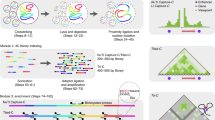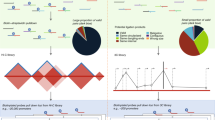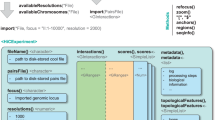Abstract
Chromosome conformation capture (3C) methods are central to understanding the link between nuclear structure and function, and the physical interactions between distal regulatory elements and promoters. However, no one method is appropriate to address all biological questions, as each variant differs markedly in resolution, reproducibility, throughput and biases. A thorough appreciation of the strengths and weaknesses of each technique is critical when choosing the correct method for a specific application or for gauging how best to interpret different sources of data. In addition, the analysis method must be carefully considered, as this choice can profoundly affect the output. In this Review, we describe and compare the different available 3C-based approaches, with a focus on the analysis of mammalian genomes.
This is a preview of subscription content, access via your institution
Access options
Access Nature and 54 other Nature Portfolio journals
Get Nature+, our best-value online-access subscription
$29.99 / 30 days
cancel any time
Subscribe to this journal
Receive 12 print issues and online access
$259.00 per year
only $21.58 per issue
Buy this article
- Purchase on Springer Link
- Instant access to full article PDF
Prices may be subject to local taxes which are calculated during checkout






Similar content being viewed by others
Accession codes
References
Mikkelsen, T.S. et al. Genome-wide maps of chromatin state in pluripotent and lineage-committed cells. Nature 448, 553–560 (2007).
Robertson, G. et al. Genome-wide profiles of STAT1 DNA association using chromatin immunoprecipitation and massively parallel sequencing. Nat. Methods 4, 651–657 (2007).
Hesselberth, J.R. et al. Global mapping of protein-DNA interactions in vivo by digital genomic footprinting. Nat. Methods 6, 283–289 (2009).
Buenrostro, J.D., Giresi, P.G., Zaba, L.C., Chang, H.Y. & Greenleaf, W.J. Transposition of native chromatin for fast and sensitive epigenomic profiling of open chromatin, DNA-binding proteins and nucleosome position. Nat. Methods 10, 1213–1218 (2013).
Stamatoyannopoulos, J. Connecting the regulatory genome. Nat. Genet. 48, 479–480 (2016).
Sanyal, A., Lajoie, B.R., Jain, G. & Dekker, J. The long-range interaction landscape of gene promoters. Nature 489, 109–113 (2012).
Bulger, M. & Groudine, M. Functional and mechanistic diversity of distal transcription enhancers. Cell 144, 327–339 (2011).
Dixon, J.R. et al. Topological domains in mammalian genomes identified by analysis of chromatin interactions. Nature 485, 376–380 (2012).
Nora, E.P. et al. Spatial partitioning of the regulatory landscape of the X-inactivation centre. Nature 485, 381–385 (2012).
Tolhuis, B., Palstra, R.J., Splinter, E., Grosveld, F. & de Laat, W. Looping and interaction between hypersensitive sites in the active beta-globin locus. Mol. Cell 10, 1453–1465 (2002).This is the first use of 3C to define interactions between regulatory elements in mammalian cells.
Tan-Wong, S.M. et al. Gene loops enhance transcriptional directionality. Science 338, 671–675 (2012).
Hsieh, T.H. et al. Mapping nucleosome resolution chromosome folding in yeast by micro-C. Cell 162, 108–119 (2015).
Hsieh, T.-H.S., Fudenberg, G., Goloborodko, A. & Rando, O.J. Micro-C XL: assaying chromosome conformation from the nucleosome to the entire genome. Nat Methods 13, 1009–1011 (2016).
Mukherjee, S., Erickson, H. & Bastia, D. Detection of DNA looping due to simultaneous interaction of a DNA-binding protein with two spatially separated binding sites on DNA. Proc. Natl. Acad. Sci. USA 85, 6287–6291 (1988).
Mitchell, M.A. & Dervan, P.B. Interhelical DNA-DNA crosslinking. Bis(monoazidomethidium)octaoxahexacosanediamine: a probe of packaged nucleic acid. J. Am. Chem. Soc. 104, 4265–4266 (1982).
Dekker, J., Rippe, K., Dekker, M. & Kleckner, N. Capturing chromosome conformation. Science 295, 1306–1311 (2002).This is the seminal paper first describing chromosome conformation capture in yeast.
Marbouty, M. et al. Condensin- and replication-mediated bacterial chromosome folding and origin condensation revealed by Hi-C and super-resolution imaging. Mol. Cell 59, 588–602 (2015).
Sexton, T. et al. Three-dimensional folding and functional organization principles of the Drosophila genome. Cell 148, 458–472 (2012).
Lieberman-Aiden, E. et al. Comprehensive mapping of long-range interactions reveals folding principles of the human genome. Science 326, 289–293 (2009).This paper first described the Hi-C method, and it describes large-scale organization of chromatin as a fractal globule.
Davies, J.O. et al. Multiplexed analysis of chromosome conformation at vastly improved sensitivity. Nat. Methods 13, 74–80 (2016).This paper describes the highest resolution and sensitivity available with a one vs. all approach using NG Capture-C, which is additionally capable of high levels of multiplexing of viewpoints.
Lucas, J.S., Zhang, Y., Dudko, O.K. & Murre, C. 3D trajectories adopted by coding and regulatory DNA elements: first-passage times for genomic interactions. Cell 158, 339–352 (2014).
Nagano, T. et al. Single-cell Hi-C reveals cell-to-cell variability in chromosome structure. Nature 502, 59–64 (2013).
Gavrilov, A.A. et al. Disclosure of a structural milieu for the proximity ligation reveals the elusive nature of an active chromatin hub. Nucleic Acids Res. 41, 3563–3575 (2013).
Nagano, T. et al. Comparison of Hi-C results using in-solution versus in-nucleus ligation. Genome Biol. 16, 175 (2015).
Rao, S.S. et al. A 3D map of the human genome at kilobase resolution reveals principles of chromatin looping. Cell 159, 1665–1680 (2014).This paper describes the highest possible resolution currently achievable with genome-wide all vs. all approaches using Hi-C.
Spilianakis, C.G. & Flavell, R.A. Long-range intrachromosomal interactions in the T helper type 2 cytokine locus. Nat. Immunol. 5, 1017–1027 (2004).
Liu, Z. & Garrard, W.T. Long-range interactions between three transcriptional enhancers, active Vkappa gene promoters, and a 3′ boundary sequence spanning 46 kilobases. Mol. Cell. Biol. 25, 3220–3231 (2005).
Vernimmen, D. et al. Chromosome looping at the human alpha-globin locus is mediated via the major upstream regulatory element (HS-40). Blood 114, 4253–4260 (2009).
Vernimmen, D., De Gobbi, M., Sloane-Stanley, J.A., Wood, W.G. & Higgs, D.R. Long-range chromosomal interactions regulate the timing of the transition between poised and active gene expression. EMBO J. 26, 2041–2051 (2007).
Zhou, G.L. et al. Active chromatin hub of the mouse alpha-globin locus forms in a transcription factory of clustered housekeeping genes. Mol. Cell. Biol. 26, 5096–5105 (2006).
Zhao, Z. et al. Circular chromosome conformation capture (4C) uncovers extensive networks of epigenetically regulated intra- and interchromosomal interactions. Nat. Genet. 38, 1341–1347 (2006).
Simonis, M. et al. Nuclear organization of active and inactive chromatin domains uncovered by chromosome conformation capture-on-chip (4C). Nat. Genet. 38, 1348–1354 (2006).
Shore, D., Langowski, J. & Baldwin, R.L. DNA flexibility studied by covalent closure of short fragments into circles. Proc. Natl. Acad. Sci. USA 78, 4833–4837 (1981).
Stadhouders, R. et al. Multiplexed chromosome conformation capture sequencing for rapid genome-scale high-resolution detection of long-range chromatin interactions. Nat. Protoc. 8, 509–524 (2013).
Simonis, M., Kooren, J. & de Laat, W. An evaluation of 3C-based methods to capture DNA interactions. Nat. Methods 4, 895–901 (2007).
Schwartzman, O. et al. UMI-4C for quantitative and targeted chromosomal contact profiling. Nat. Methods 13, 685–691 (2016).
Andrey, G. et al. A switch between topological domains underlies HoxD genes collinearity in mouse limbs. Science 340, 1234167 (2013).This paper uses 4C to delineate the changes in gene regulation and interaction profiles at the HoxD genes during limb development.
de Wit, E. et al. The pluripotent genome in three dimensions is shaped around pluripotency factors. Nature 501, 227–231 (2013).
Pasquali, L. et al. Pancreatic islet enhancer clusters enriched in type 2 diabetes risk-associated variants. Nat. Genet. 46, 136–143 (2014).
Simonis, M. et al. High-resolution identification of balanced and complex chromosomal rearrangements by 4C technology. Nat. Methods 6, 837–842 (2009).
Gröschel, S. et al. A single oncogenic enhancer rearrangement causes concomitant EVI1 and GATA2 deregulation in leukemia. Cell 157, 369–381 (2014).
Dostie, J. et al. Chromosome conformation capture carbon copy (5C): a massively parallel solution for mapping interactions between genomic elements. Genome Res. 16, 1299–1309 (2006).
Hughes, J.R. et al. Analysis of hundreds of cis-regulatory landscapes at high resolution in a single, high-throughput experiment. Nat. Genet. 46, 205–212 (2014).
Yaffe, E. & Tanay, A. Probabilistic modeling of Hi-C contact maps eliminates systematic biases to characterize global chromosomal architecture. Nat. Genet. 43, 1059–1065 (2011).
Imakaev, M. et al. Iterative correction of Hi-C data reveals hallmarks of chromosome organization. Nat. Methods 9, 999–1003 (2012).
Hu, M. et al. HiCNorm: removing biases in Hi-C data via Poisson regression. Bioinformatics 28, 3131–3133 (2012).
Jin, F. et al. A high-resolution map of the three-dimensional chromatin interactome in human cells. Nature 503, 290–294 (2013).
Naumova, N. et al. Organization of the mitotic chromosome. Science 342, 948–953 (2013).
Zhang, Y. et al. Spatial organization of the mouse genome and its role in recurrent chromosomal translocations. Cell 148, 908–921 (2012).
Ramani, V. et al. Massively multiplex single-cell Hi-C. Preprint at http://biorxiv.org/content/early/2016/07/23/065052 (2016).
Hsieh, T.S., Fudenberg, G., Goloborodko, A. & Rando, O.J. Micro-C XL: assaying chromosome conformation from the nucleosome to the entire genome. Nat. Methods 13, 1009–1011 (2016).
Ma, W. et al. Fine-scale chromatin interaction maps reveal the cis-regulatory landscape of human lincRNA genes. Nat. Methods 12, 71–78 (2015).
Cairns, J. et al. CHiCAGO: robust detection of DNA looping interactions in Capture Hi-C data. Genome Biol. 17, 127 (2016).
Schoenfelder, S. et al. The pluripotent regulatory circuitry connecting promoters to their long-range interacting elements. Genome Res. 25, 582–597 (2015).
Mifsud, B. et al. Mapping long-range promoter contacts in human cells with high-resolution capture Hi-C. Nat. Genetics 47, 598–606 (2015).
Kolovos, P. et al. Targeted chromatin capture (T2C): a novel high resolution high throughput method to detect genomic interactions and regulatory elements. Epigenetics Chromatin 7, 10 (2014).
Fullwood, M.J. et al. An oestrogen-receptor-alpha-bound human chromatin interactome. Nature 462, 58–64 (2009).
Kieffer-Kwon, K.R. et al. Interactome maps of mouse gene regulatory domains reveal basic principles of transcriptional regulation. Cell 155, 1507–1520 (2013).
Mumbach, M.R. et al. HiChIP: efficient and sensitive analysis of protein-directed genome architecture. Nat. Methods 13, 919–922 (2016).
Brackley, C.A. et al. Predicting the three-dimensional folding of cis-regulatory regions in mammalian genomes using bioinformatic data and polymer models. Genome Biol. 17, 59 (2016).
Fraser, J. et al. Hierarchical folding and reorganization of chromosomes are linked to transcriptional changes in cellular differentiation. Mol. Syst. Biol. 11, 852 (2015).
Li, G. et al. Extensive promoter-centered chromatin interactions provide a topological basis for transcription regulation. Cell 148, 84–98 (2012).
van de Werken, H.J. et al. Robust 4C-seq data analysis to screen for regulatory DNA interactions. Nat. Methods 9, 969–972 (2012).
Phillips-Cremins, J.E. et al. Architectural protein subclasses shape 3D organization of genomes during lineage commitment. Cell 153, 1281–1295 (2013).
Klein, F.A. et al. FourCSeq: analysis of 4C sequencing data. Bioinformatics 31, 3085–3091 (2015).
de Wit, E. et al. CTCF Binding polarity determines chromatin looping. Mol. Cell 60, 676–684 (2015).
Sauria, M.E.G., Phillips-Cremins, J.E., Corces, V.G. & Taylor, J. HiFive: a tool suite for easy and efficient HiC and 5C data analysis. Genome Biol. 16, 237 (2015).
Servant, N. et al. HiC-Pro: an optimized and flexible pipeline for Hi-C data processing. Genome Biol. 16, 259 (2015).
Wingett, S. et al. HiCUP: pipeline for mapping and processing Hi-C data. F1000Res 4, 1310 (2015).
Durand Neva, C. et al. Juicer provides a one-click system for analyzing loop-resolution Hi-C experiments. Cell Systems 3, 95–98 (2016).
Li, G. et al. ChIA-PET tool for comprehensive chromatin interaction analysis with paired-end tag sequencing. Genome Biol. 11, R22 (2010).
Acknowledgements
We thank members of Hughes and Higgs groups for helpful comments and discussions. We thank our funding bodies: Wellcome Trust Strategic Award ref. 106130/Z/14/Z (J.R.H. and D.R.H.); Wellcome Trust Clinical Research Training Fellowship ref. 098931/Z/12/Z (JOJD) and Wellcome trust doctoral training programme ref. 105281/Z/14/Z (AMO).
Author information
Authors and Affiliations
Corresponding author
Ethics declarations
Competing interests
A patent for NG Capture-C has been filed and is pending.
Integrated supplementary information
Supplementary Figure 1 Chromatin, 4C and NG Capture-C data for the alpha globin locus in mouse erythroid cells.
The DNaseI hypersensitivity track (green), marking open chromatin, is shown at the top. Below are ChIP-seq profiles for H3K4me3, H3K4me1 and CTCF, that highlight promoters, enhancers and CTCF binding sites respectively (Hughes et al., 2014).
The raw and normalized 4Cseq profiles are shown below (van der Werken et al., 2012). The NG Capture-C profiles are an average of 4 replicates in erythroid cells and 3 ES cell replicates. The bottom track shows significant differences (-log10 p value) between the interaction profiles when the gene is active (erythroid cells) and inactive (ES cells). The data can be analysed by DESeq2, which is used for comparative analysis of several different types of count based sequencing data, particularly RNAseq.
Supplementary Figure 2 Chromatin data for the Sox2 locus in mouse ES cells.
The DNaseI hypersensitivity track, marks open chromatin and nonspecifically highlights regulatory elements. Below are ChIP-seq profiles for H3K4me1, H3K4me3, mediator (Med1) Oct-4, Nanog, and CTCF, which allow the DNAseI hypersensitive sites to be defined further.
A cluseter of hypersensitive sites 85-111kb from the promoter of the gene are defined as a superenhancer in ES cells by Whyte et al., 2013. However, the gene has several other cell type specific regulatory, which extend nearly 1Mb away from the promoter. These tend to be with CTCF sites (highlighted in purple) although there is an additional element potential regulatory element bound by Nanog and Oct4 (HS+683).
ES cell data: DNAseI-seq (ENCODE UW); ChIP-seq H3K4me1 and H3K4me3 (ENCODE/LICR); CTCF (LICR GSM918748); MED1 (Young lab GSM1038259), Sox2 (Young lab GSM1082341), Nanog (Young lab GSM1082342), Oct4 (Young lab GSM1082340)
Supplementary information
Supplementary Text and Figures
Supplementary Note 1 and Supplementary Figures 1–2 (PDF 4474 kb)
Rights and permissions
About this article
Cite this article
Davies, J., Oudelaar, A., Higgs, D. et al. How best to identify chromosomal interactions: a comparison of approaches. Nat Methods 14, 125–134 (2017). https://doi.org/10.1038/nmeth.4146
Received:
Accepted:
Published:
Issue Date:
DOI: https://doi.org/10.1038/nmeth.4146
This article is cited by
-
Determining chromatin architecture with Micro Capture-C
Nature Protocols (2023)
-
Toward a comprehensive catalog of regulatory elements
Human Genetics (2023)
-
Bacon: a comprehensive computational benchmarking framework for evaluating targeted chromatin conformation capture-specific methodologies
Genome Biology (2022)
-
Capture-C: a modular and flexible approach for high-resolution chromosome conformation capture
Nature Protocols (2022)
-
Engineered model of t(7;12)(q36;p13) AML recapitulates patient-specific features and gene expression profiles
Oncogenesis (2022)



